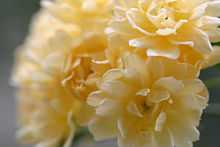Rosa banksiae
| Rosa banksiae | |
|---|---|
 | |
| Scientific classification | |
| Kingdom: | Plantae |
| (unranked): | Angiosperms |
| (unranked): | Eudicots |
| (unranked): | Rosids |
| Order: | Rosales |
| Family: | Rosaceae |
| Genus: | Rosa |
| Species: | R. banksiae |
| Binomial name | |
| Rosa banksiae W.T.Aiton[1] | |
Rosa banksiae, common names Lady Banks' Rose or just Banks' rose, is a species of flowering plant in the rose family, native to central and western China, in the provinces of Gansu, Guizhou, Henan, Hubei, Jiangsu, Sichuan and Yunnan, at altitudes of 500–2,200 m (1,640–7,218 ft).
Description
It is a scrambling shrubby vine growing vigorously to 6 m (20 ft) tall. Unlike most roses, it is practically thornless, though it may bear some prickles up to 5 mm long, particularly on stout, strong shoots. The leaves are evergreen, 4–6 cm long, with three to five (rarely seven) leaflets 2–5 cm long with a serrated margin. The flowers are small, 1.5-2.5 cm diameter, white or pale yellow. It is amongst the earliest flowering of all roses, usually appearing during May in the northern hemisphere, though cold weather can delay flowering.[2] All Lady Banks' roses are said to smell of violets to varying degrees.
The rose is named after Lady Banks, the wife of the botanist Sir Joseph Banks (after whom the Banks Peninsula is named).
Varieties
There are two varieties:[3]
- Rosa banksiae var. banksiae - flowers semi-double or double, with numerous petals replacing most or all of the stamens; a cultigen developed in Chinese gardens
- Rosa banksiae var. normalis - flowers single, with five petals; the natural wild form of the species
Cultivation and uses


R. banksiae has likely been grown in the gardens of China for hundreds of years. The species was introduced to Europe by William Kerr, who had been sent on a plant-hunting expedition by Sir Joseph Banks. He bought the first Lady Banks' Rose, subsequently named the white Lady Banks (R. banksiae var. banksiae) from the famous Fa Tee nursery in 1807. A number of other forms were subsequently discovered growing in China, including R. banksiae var. normalis (see above), and R. banksiae 'Lutea', the yellow Lady Banks' rose (brought to Europe in 1824 by J. D. Park). This cultivar has gained the Royal Horticultural Society's Award of Garden Merit[4]
According to Guinness, the world's largest rosebush was planted in Tombstone, Arizona, in 1885[5] and still flourishes today in the city's sunny climate. This rose bush now covers 8,000 square feet (740 m2) of the roof on an inn, and has a 12-foot (3.7 m) circumference trunk.[6]
References
- ↑ "Tropicos".
- ↑ RHS A-Z encyclopedia of garden plants. United Kingdom: Dorling Kindersley. 2008. p. 1136. ISBN 1405332964.
- ↑
- ↑ "Rosa banksiae 'Lutea' (Ra/d) AGM".
- ↑ 2003. "Tombstone's Shady Lady" The Tombstone Times.
- ↑ Photo on Flickr
| Wikimedia Commons has media related to Rosa banksiae. |
- Climbing Roses of the World by Charles Quest-Ritson
- The Graham Stuart Thomas Rose Book by Graham Stuart Thomas